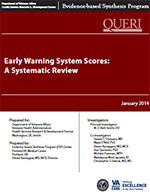
|
Investigators:
Principal Investigator:
M. E. Beth Smith, DO Evidence-based Synthesis Program (ESP) Center, Portland VA Medical Center,
Portland, OR
Washington (DC): Department of Veterans Affairs; January 2014 |
Download PDF: Complete Report, Executive Summary, Report, Appendices
Early warning system (EWS) scores are tools used by hospital care teams to recognize the early signs of clinical deterioration in order to initiate early intervention and management, such as increasing nursing attention, informing the provider, or activating a rapid response or medical emergency team. These tools involve assigning a numeric value to several physiologic parameters (e.g., systolic blood pressure, heart rate, oxygen saturation, respiratory rate, level of consciousness, and urine output) to derive a composite score that is used to identify a patient at risk of deterioration. Most are based on an aggregate weighted system in which the elements are assigned different points for the degree of physiological abnormality. Observational studies suggest that patients often show signs of clinical deterioration up to 24 hours prior to a serious clinical event requiring an intensive intervention. Delays in treatment or inadequate care of patients on general hospital wards may result in increased admissions to the intensive care unit (ICU), increased length of hospital stay, cardiac arrest, or death.
The purpose of the EWS scores is to ensure timely and appropriate management of deteriorating patients on general hospital wards. This is potentially a significant topic for the VA, as the Portland, Oregon VA Medical Center has implemented a Modified Early Warning System (MEWS) and there are plans to implement this nationally. This evidence review will be used by the Office of Nursing Services Clinical Practice Programs ICU Workgroup to develop guidelines for the development and implementation of EWS scores at facilities within the VA system and will be used to identify gaps in evidence that warrant further research.
Key questions:
Key Question 1: In adult patients admitted to the general medicine or surgical wards, what is the predictive value of EWS scores for patient health outcomes within 48 hours of data collection, including shortterm mortality (all cause or disease specific), cardiac arrest and pulmonary arrest? Which factors contribute to the predictive ability of EWS scores and does predictive ability vary with specific subgroups of patients?
Key Question 2A: What is the impact of using Early Warning Systems on patient health outcomes including 30- day mortality, cardiovascular events (cardiac arrest, acute coronary syndrome and cardiogenic shock), use of vasopressors, number of ventilator days, respiratory failure and length of hospital stay?
Key Question 2B:
What is the impact of EWS on resource utilization including but not limited to admissions to the
intensive care unit (ICU), length of hospital stay, and use of Rapid Response Teams (RRT)?
We met regularly throughout the review with members of a technical expert panel, some
of whom served as key informants during the development phase, to oversee the clinical
applicability, content completeness, and methodological rigor of the review process.
The population comprises adults admitted to the general medicine or surgical wards.
Interventions include any Early Warning System scoring or other established scoring system
designed to identify deteriorating patients on hospital wards, including but not limited to
Modified Early Warnings Systems (MEWS), Patient at Risk (PAR) score, Physiological Scoring
Systems (PSS), Vital Sign Score (VSS), Manchester Triage System, BioSign, VitalPAC Early
Warning Score (ViEWS) and Physiological Observation Track and Trigger System (POTTS).